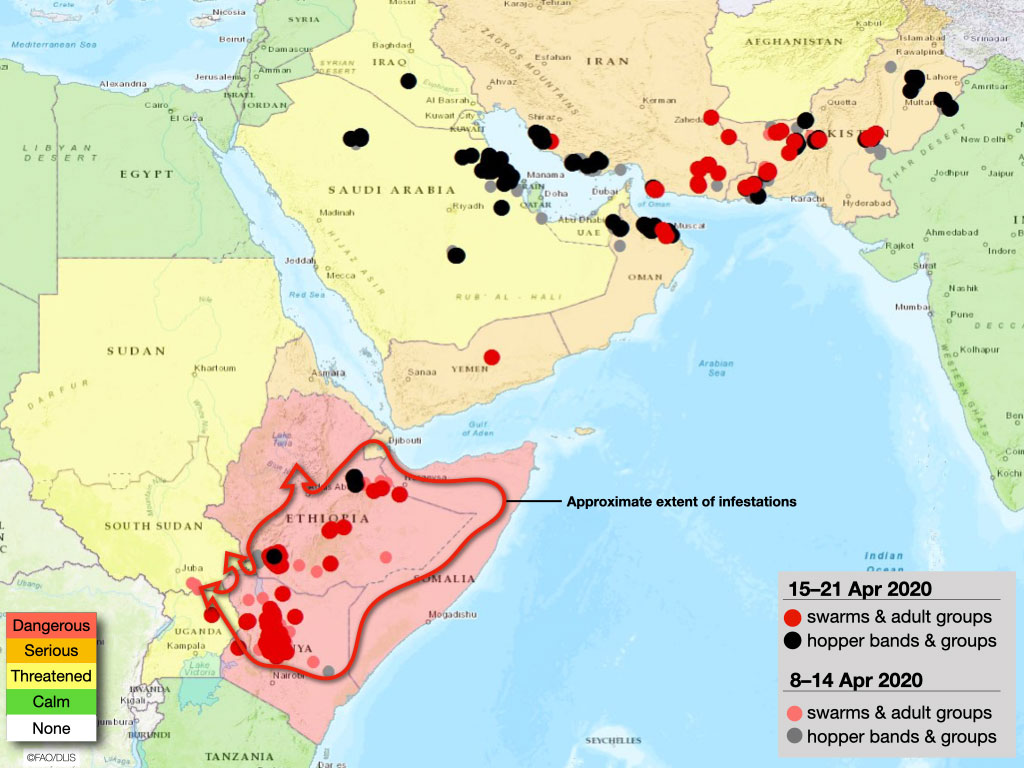East Africa: Despite Lockdowns, FAO Prioritizes Desert Locust Containment
The desert locust upsurge in East Africa remains “extremely alarming” as more swarms form and mature in northern and central Kenya, southern Ethiopia and probably in Somalia, according to an update on Apr. 21 by the Food and Agriculture Organization of the UN.
“This represents an unprecedented threat to food security and livelihoods because it coincides with the beginning of the long rains and the planting season,” according to an FAO statement. “Although ground and aerial control operations are in progress, widespread rains that fell in late March will allow the new swarms to mostly stay in place, mature and lay eggs while a few swarms could move from Kenya to Uganda, South Sudan and Ethiopia. During May, the eggs will hatch into hopper bands that will form new swarms in late June and July, which coincides with the start of the harvest.”

Spring breeding will cause a further increase in locust infestations in East Africa, eastern Yemen and southern Iran in the coming months, says FAO.
Despite restrictions on movement of personnel and equipment resulting from the COVID-19 pandemic, FAO said it is continuing to work with national governments, farmers and agricultural producers to contain the outbreak.
“There is no significant slowdown because all the affected countries working with FAO consider Desert Locusts a national priority,” said Cyril Ferrand, FAO’s Resilience Team Leader for East Africa. “While lockdown is becoming a reality, people engaged in the fight against the upsurge are still allowed to conduct surveillance, and air and ground control operations.”
FAO said it is augmenting national efforts by providing support for surveillance as well as aerial and ground spraying being conducted in 10 affected countries. So far more than 240,000 hectares have been treated with chemical pesticides or biopesticides across the region and 740 people have been trained up to conduct ground locust control operations. But COVID-19 has had an impact on the supply of motorized sprayers and pesticides.
“The biggest challenge we are facing at the moment is the supply of pesticides and we have delays because global air freight has been reduced significantly,” Ferrand said. “Our absolute priority is to prevent a breakdown in pesticide stocks in each country. That would be dramatic for rural populations whose livelihoods and food security depend on the success of our control campaign.”
As COVID-19 restricts the movement of personnel in the field, FAO is intensifying remote data collection and the network of partners, civil society, extension workers and grassroot organizations is critical for providing information from remote locations especially in Ethiopia, Kenya, Somalia and South Sudan. FAO is encouraging all countries to use eLocust3, a handheld tablet and app, which records and transmits data in real time via satellite to national locust centers and to the Desert Locust Information Service (DLIS) based at FAO headquarters in Rome.
Since 2015, more than 450 of these handheld devices have been distributed to teams in northern Africa, the Near East and southwest Asia, allowing the transfer of real-time data from the middle of the desert directly to the national locust office and to FAO’s headquarters. More recently, FAO has developed a version of eLocust3 that can be used on mobile phones and a GPS device in order to broaden usage and coverage. “We need to rely on a network of partners in the field in order to collect vital information because we cannot go everywhere due to COVID-19,” Ferrand said.
According to FAO, the Desert Locust is considered the most destructive migratory pest in the world and a single swarm covering one square kilometer contains up to 80 million locusts. FAO estimates the number of locusts could increase another 20 times during the upcoming rainy season unless control activities are stepped up. The current situation represents an unprecedented threat to food security and livelihoods that could lead to further suffering, displacement and potential tensions. FAO recently scaled up its Desert Locust appeal to $153.2 million and so far $111.1 million has been pledged or received.







